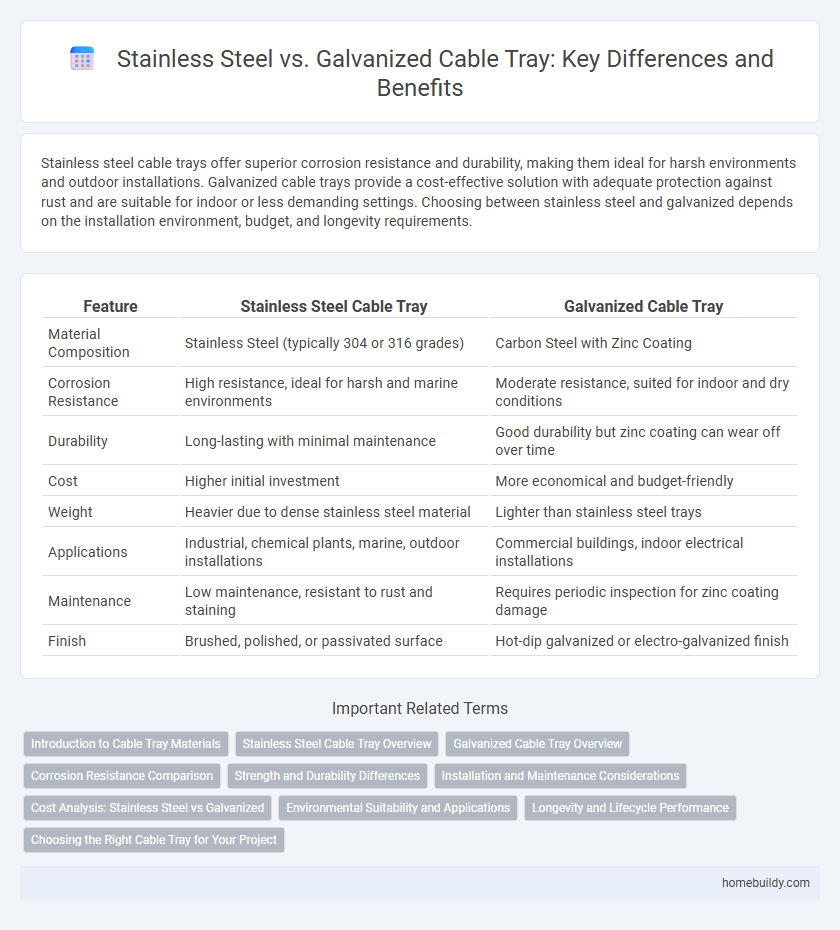Stainless steel cable trays offer superior corrosion resistance and durability, making them ideal for harsh environments and outdoor installations. Galvanized cable trays provide a cost-effective solution with adequate protection against rust and are suitable for indoor or less demanding settings. Choosing between stainless steel and galvanized depends on the installation environment, budget, and longevity requirements.
Table of Comparison
| Feature | Stainless Steel Cable Tray | Galvanized Cable Tray |
|---|---|---|
| Material Composition | Stainless Steel (typically 304 or 316 grades) | Carbon Steel with Zinc Coating |
| Corrosion Resistance | High resistance, ideal for harsh and marine environments | Moderate resistance, suited for indoor and dry conditions |
| Durability | Long-lasting with minimal maintenance | Good durability but zinc coating can wear off over time |
| Cost | Higher initial investment | More economical and budget-friendly |
| Weight | Heavier due to dense stainless steel material | Lighter than stainless steel trays |
| Applications | Industrial, chemical plants, marine, outdoor installations | Commercial buildings, indoor electrical installations |
| Maintenance | Low maintenance, resistant to rust and staining | Requires periodic inspection for zinc coating damage |
| Finish | Brushed, polished, or passivated surface | Hot-dip galvanized or electro-galvanized finish |
Introduction to Cable Tray Materials
Stainless steel cable trays offer superior corrosion resistance, making them ideal for harsh environments such as chemical plants, marine applications, and outdoor installations. Galvanized cable trays, coated with zinc, provide cost-effective protection against rust and are commonly used in general industrial and commercial settings. Selecting the appropriate tray material depends on environmental conditions, budget constraints, and the desired longevity of the cable management system.
Stainless Steel Cable Tray Overview
Stainless steel cable trays offer superior corrosion resistance, making them ideal for harsh environments such as chemical plants, marine applications, and outdoor installations. Their durability and strength ensure long-term support for heavy cable loads while maintaining structural integrity under extreme temperatures. Compared to galvanized trays, stainless steel provides enhanced longevity and requires less maintenance, resulting in lower lifecycle costs.
Galvanized Cable Tray Overview
Galvanized cable trays are constructed from steel coated with a layer of zinc, offering robust corrosion resistance, especially in outdoor and industrial environments. They provide a cost-effective solution compared to stainless steel trays, with sufficient durability for most applications requiring moderate exposure to moisture and chemicals. Galvanized trays are widely used in electrical installations for their balance of strength, protection against rust, and economic advantage in large-scale cable management projects.
Corrosion Resistance Comparison
Stainless steel cable trays exhibit superior corrosion resistance due to their chromium content, which forms a passive oxide layer protecting against rust and chemical damage, making them ideal for harsh environments such as coastal or industrial areas. Galvanized cable trays, coated with a layer of zinc, provide moderate corrosion protection effective in less aggressive conditions but may degrade over time when exposed to moisture or salt. Choosing stainless steel over galvanized trays ensures longer durability and reduced maintenance costs in corrosive settings.
Strength and Durability Differences
Stainless steel cable trays offer superior strength and corrosion resistance, making them ideal for harsh environments such as chemical plants and marine applications. Galvanized cable trays provide adequate durability for general indoor and outdoor use but are more susceptible to rust and wear over time compared to stainless steel versions. The enhanced tensile strength and longevity of stainless steel trays justify their higher initial cost in demanding industrial settings.
Installation and Maintenance Considerations
Stainless steel cable trays offer superior corrosion resistance, reducing the need for frequent maintenance in harsh environments compared to galvanized cable trays. Installation of stainless steel trays can be more labor-intensive and costly due to their weight and the requirement for specialized tools or fasteners. Galvanized cable trays, while easier and faster to install because of their lighter weight, may require periodic inspections and repainting to prevent rust and prolong service life.
Cost Analysis: Stainless Steel vs Galvanized
Stainless steel cable trays typically incur higher initial costs compared to galvanized cable trays due to the expense of raw materials and manufacturing processes. However, stainless steel offers superior corrosion resistance and longevity, potentially reducing maintenance and replacement expenses over time. Galvanized cable trays are more budget-friendly upfront but may require frequent upkeep and earlier replacement in harsh environments, impacting long-term cost efficiency.
Environmental Suitability and Applications
Stainless steel cable trays offer superior corrosion resistance, making them ideal for harsh environments such as coastal areas, chemical plants, and food processing facilities where exposure to moisture and corrosive agents is high. Galvanized cable trays, coated with a protective zinc layer, are well-suited for indoor or less aggressive outdoor settings where moderate resistance to rust and corrosion is sufficient. Selecting between stainless steel and galvanized cable trays depends on environmental conditions, cost considerations, and the specific application's durability requirements.
Longevity and Lifecycle Performance
Stainless steel cable trays offer superior corrosion resistance and durability, making them ideal for harsh environments and extending system longevity beyond galvanized alternatives. Galvanized cable trays provide a cost-effective solution with adequate protection against rust but generally exhibit shorter lifecycle performance under aggressive conditions. Investing in stainless steel trays ensures reduced maintenance and replacement costs over time, maximizing overall lifecycle efficiency.
Choosing the Right Cable Tray for Your Project
Stainless steel cable trays offer superior corrosion resistance and durability, making them ideal for harsh environments or outdoor installations with exposure to moisture and chemicals. Galvanized cable trays provide a cost-effective solution with adequate protection against rust, suitable for indoor or less aggressive environments. Selecting the right cable tray depends on project requirements, environmental conditions, and budget constraints to ensure long-term performance and safety.
Stainless steel cable tray vs galvanized cable tray Infographic

 homebuildy.com
homebuildy.com